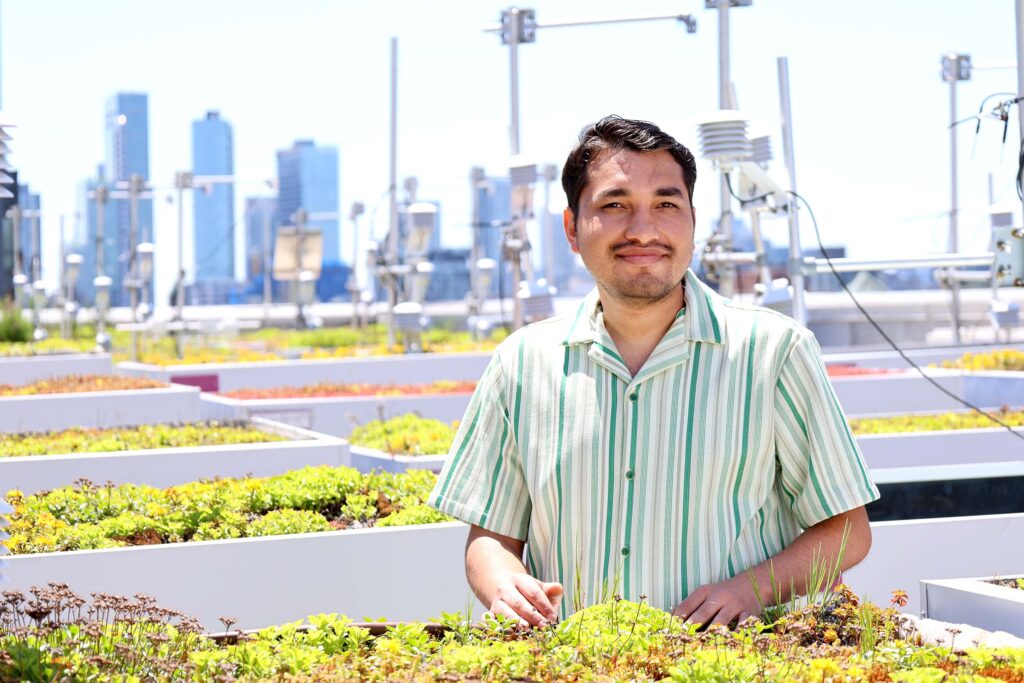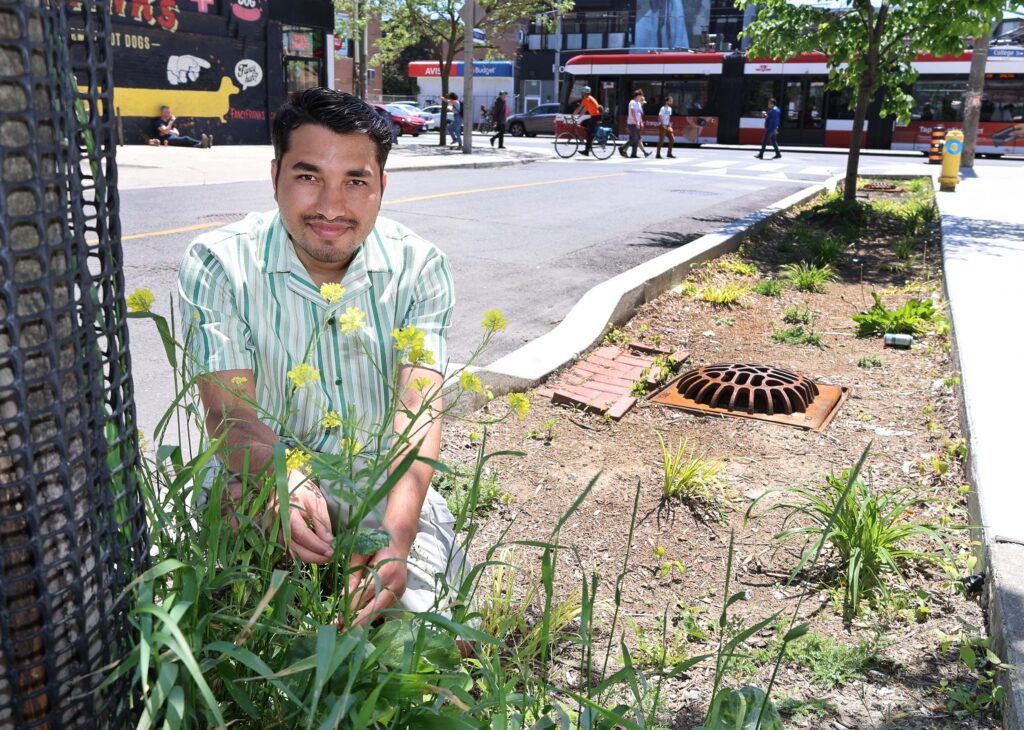
CivMin PhD student Bhabishya Khaniya has been selected as one of the recipients of the 2023-2024 Vanier Canada Graduate Scholarships (Vanier CGS) awarded by the Natural Sciences and Engineering Research Council (NSERC).
Providing $150,000 in funding over three years, the scholarship recognizes PhD candidates at Canadian universities who demonstrate excellence in the areas of leadership, research impact and academics. Khaniya is supervised by Professor Jennifer Drake, who recently left CivMin to take a position at Carleton University, and Dr. Chris Szota and Professor Tim Fletcher from the University of Melbourne. His research in the area of bioretention systems complements his supervisor’s expertise in green stormwater infrastructure and urban waterway ecosystem management.
The Vanier CGS program plays an important role in fulfilling the Government of Canada’s Science and Technology strategy to promote the development and application of leading-edge knowledge, support the development of a world-class workforce, and attract and retain the world’s top graduate students. Each year, these highly prestigious scholarships are offered to doctoral students who have demonstrated strong leadership skills and a high standard of scholarly achievement in graduate studies in the social sciences and humanities, natural sciences and engineering, and health.
CivMin had a chat with Khaniya to talk about becoming a Vanier Scholar and more.
Please tell us a little about yourself.
Hello, my name is Bhabishya Khaniya, a PhD student co-supervised by Professor Jennifer Drake from the University of Toronto (now at Carleton) and Professor Chris Szota, and Professor Tim Fletcher from the University of Melbourne. I started at U of T in Fall 2022. I am doing a joint PhD with the University of Toronto and the University of Melbourne.
What’s your area of research?
I’m studying bioretention systems which are a type of green stormwater infrastructure systems that help to manage stormwater runoff generated from impervious areas. These structures protect urban waterway ecosystem and help to make cities more climate resilient by reducing floods, replenishing groundwater, and also mitigating urban heat island effects. There has been growing interest in installing bioretention systems in cities especially around the road right-of-way areas to manage stormwater runoff at the source itself. But the challenge is that not all these systems that cities have installed are performing very well. What are seeing now is a lot of problems in terms of design, construction, and maintenance of these systems, and as a result, these structures aren’t performing as they should. In my research, I’m studying the failure mechanisms of these structures to identify bioretention designs and configurations that are least susceptible to failures and are universally resilient in different climates and communities.

Can you give us a very simple idea of what one of these structures would look like or how it works?
Bioretention systems are soil-plant-based systems. The main components of bioretention systems are vegetation, soil, and hydraulic flow structures such as inlets, outlets, and underdrain pipe. The vegetation at the top is followed by a soil layer usually called filter media layer. The filter media that we use in bioretention systems are engineered soil media. It has a sandy texture with high hydraulic conductivity and consists of several other amendments that help to retain the pollutants of the stormwater runoff. When it rains on impervious surfaces, a significant amount of runoff is generated. Because the soil here is pervious, water can quickly infiltrate through these systems, and water gets stored in the pore spaces. As this water percolates through the soil, it will undergo natural treatment processes and help to remove the pollutants of the stormwater. Some of the pollutants such as nitrogen are removed by plant uptake. In this way mimicking the natural hydrological processes, bioretention system helps to reduce the volume, peak flow rate, and pollutant concentration of the stormwater runoff and protect the urban waterway ecosystem from degradation. The vegetation component is important as it provides ecosystem services benefits of urban cooling and biodiversity protection.
Are you doing this right now, in full-scale or a smaller-scale setups?
Bioretention structures have been installed in road right-of-way areas by the City of Toronto. I have installed monitoring setups in several of these sites here in Toronto that include soil moisture, and water level sensors to collect performance data and data on operational conditions. I have also collected soil samples to analyze the hydrologic and geotechnical properties of the soil.
The performance in terms of volume of water flow and this sort thing?
Yes, exactly. In terms of performance, we are looking at whether or not these structures are managing volumetric runoff and also providing water quality benefits.
You’ve been at this work for two years already. And how much longer do you think, I
Yes, it has almost been two years, and things are going quite well. Right now, I’m mainly focused on collecting data from my sites here in Toronto. Once I finish gathering data here, I’ll be heading to Melbourne, Australia to collect a similar set of data from bioretention sites there. The goal is to gather information on the performance and functionality of bioretention systems in different climates and geographical locations to establish a universal failure mechanism.
How did you get into this area? How did your academic and research path take you here?
I did my undergrad in civil engineering back in Sri Lanka (I am originally from Nepal) and that is where my interest in water resource engineering began. I enrolled in apprenticeship programs, diving into research related to low-impact development and sustainable urban drainage systems. I then pursued a master’s in sustainability management at the University of Waterloo, where I gained deeper knowledge about sustainable water resource management for creating a climate-resilient environment. Following my passion for green infrastructure solutions, I joined the Department of Civil and Mineral Engineering at the University of Toronto to continue working on low impact development and sustainable water resource management systems.
What attracted you to the University of Toronto?
Well, the University of Toronto is one of the most reputed universities in the world with its rich academic and research history, and I’m so proud to have been admitted to UofT. I was especially impressed with the research facilities and the work being carried out in Professor Drake’s lab. Another thing that drew me here is the campus’s location. Being in Toronto, a city that’s so vibrant and beautiful, feels absolutely amazing.
You have some big news too. It’s been announced that you’re now a Vanier Scholar. Tell us how that feels to be given this award… and congratulations!
It was unbelievable news for me. The first time I saw the email saying I was awarded the Vanier, it was like a dream come true! I felt this incredible rush of joy and gratitude. It truly recognized all the hard work I’ve put in and everything we’re striving to achieve. Now, I feel an added responsibility to carry out research that can solve the current issues in implementing green stormwater infrastructure solutions for climate-resilient cities. This scholarship has motivated me even more to tackle research problems that can make a real impact on people’s lives now and in the future. This award wouldn’t have been possible without the amazing support of my supervisors, Professors Drake, Szota, and Fletcher. I am deeply grateful to them for their encouragement and guidance.
By Phill Snel